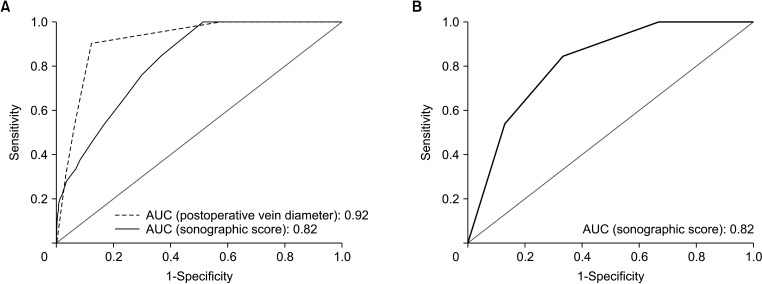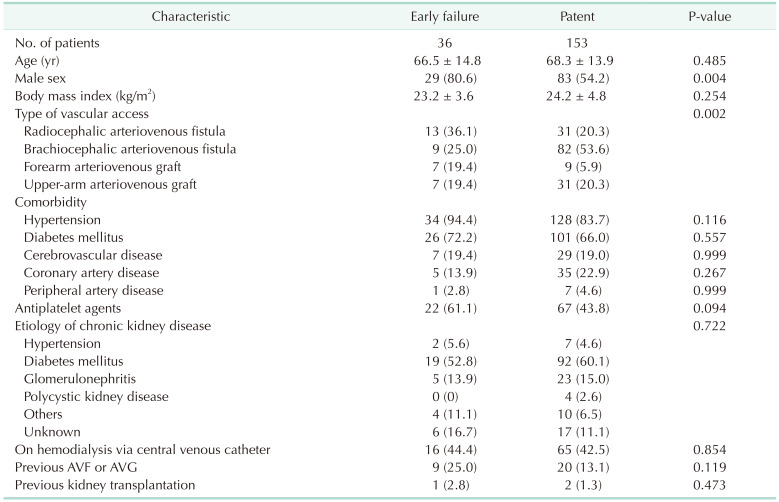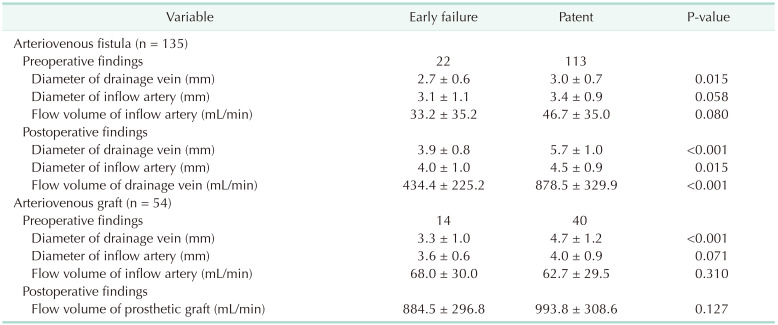1. Gameiro J, Ibeas J. Factors affecting arteriovenous fistula dysfunction: a narrative review. J Vasc Access. 2020; 21:134–147. PMID:
31113281.
2. Yap YS, Chi WC, Lin CH, Liu YC, Wu YW. Association of early failure of arteriovenous fistula with mortality in hemodialysis patients. Sci Rep. 2021; 11:5699. PMID:
33707591.
3. Polkinghorne KR, McDonald SP, Atkins RC, Kerr PG. Vascular access and all-cause mortality: a propensity score analysis. J Am Soc Nephrol. 2004; 15:477–486. PMID:
14747396.
4. Bylsma LC, Gage SM, Reichert H, Dahl SL, Lawson JH. Arteriovenous fistulae for haemodialysis: a systematic review and meta-analysis of efficacy and safety outcomes. Eur J Vasc Endovasc Surg. 2017; 54:513–522. PMID:
28843984.
5. Kim HK, Han A, Ahn S, Ko H, Chung CT, Choi KW, et al. Better efficacy of balloon assisted maturation in radial-cephalic arteriovenous fistula for hemodialysis. Vasc Specialist Int. 2021; 37:29–36.
6. Allon M. Vascular access for hemodialysis patients: new data should guide decision making. Clin J Am Soc Nephrol. 2019; 14:954–961. PMID:
30975657.
7. El Khoury R, Russeau AP, Patel N, Dabbous F, Kechker I, Lipatov S, et al. Reliability of preoperative venous mapping ultrasonography in predicting for autogenous arteriovenous fistula maturation. J Vasc Surg. 2021; 73:1787–1793. PMID:
33091513.
8. Farber A, Imrey PB, Huber TS, Kaufman JM, Kraiss LW, Larive B, et al. Multiple preoperative and intraoperative factors predict early fistula thrombosis in the Hemodialysis Fistula Maturation Study. J Vasc Surg. 2016; 63:163–170. PMID:
26718822.
9. Waheed A, Masengu A, Skala T, Li G, Jastrzebski J, Zalunardo N. A prospective cohort study of predictors of upper extremity arteriovenous fistula maturation. J Vasc Access. 2020; 21:746–752. PMID:
32340534.
10. Woodside KJ, Bell S, Mukhopadhyay P, Repeck KJ, Robinson IT, Eckard AR, et al. Arteriovenous fistula maturation in prevalent hemodialysis patients in the United States: a national study. Am J Kidney Dis. 2018; 71:793–801. PMID:
29429750.
11. Arhuidese IJ, Beaulieu RJ, Aridi HD, Locham S, Baldwin EK, Malas MB. Age-related outcomes of arteriovenous grafts for hemodialysis access. J Vasc Surg. 2020; 72:643–650. PMID:
32067881.
12. Georgiadis GS, Charalampidis DG, Argyriou C, Georgakarakos EI, Lazarides MK. The necessity for routine pre-operative ultrasound mapping before arteriovenous fistula creation: a meta-analysis. Eur J Vasc Endovasc Surg. 2015; 49:600–605. PMID:
25736517.
13. Kakkos SK, Kaplanis N, Papachristou EC, Papadoulas SI, Lampropoulos GC, Tsolakis IA, et al. The significance of inflow artery and tourniquet derived cephalic vein diameters on predicting successful use and patency of arteriovenous fistulas for haemodialysis. Eur J Vasc Endovasc Surg. 2017; 53:870–878. PMID:
28318999.
14. Misskey J, Hamidizadeh R, Faulds J, Chen J, Gagnon J, Hsiang Y. Influence of artery and vein diameters on autogenous arteriovenous access patency. J Vasc Surg. 2020; 71:158–172. PMID:
31303475.
15. Robbin ML, Greene T, Allon M, Dember LM, Imrey PB, Cheung AK, et al. Prediction of arteriovenous fistula clinical maturation from postoperative ultrasound measurements: findings from the Hemodialysis Fistula Maturation Study. J Am Soc Nephrol. 2018; 29:2735–2744. PMID:
30309898.
16. Farrington CA, Robbin ML, Lee T, Barker-Finkel J, Allon M. Early predictors of arteriovenous fistula maturation: a novel perspective on an enduring problem. J Am Soc Nephrol. 2020; 31:1617–1627. PMID:
32424000.
17. Lok CE, Huber TS, Lee T, Shenoy S, Yevzlin AS, Abreo K, et al. KDOQI clinical practice guideline for vascular access: 2019 update. Am J Kidney Dis. 2020; 75(4 Suppl 2):S1–S164. PMID:
32778223.
18. Lee T, Magill M, Burke SK, Blair AT, Robbin ML, Allon M. Comparison of postoperative ultrasound criteria to predict unassisted use of arteriovenous fistulas for hemodialysis. J Vasc Access. 2018; 19:167–171. PMID:
29283177.
19. Beathard GA, Lok CE, Glickman MH, Al-Jaishi AA, Bednarski D, Cull DL, et al. Definitions and end points for interventional studies for arteriovenous dialysis access. Clin J Am Soc Nephrol. 2018; 13:501–512. PMID:
28729383.
20. Casey ET, Murad MH, Rizvi AZ, Sidawy AN, McGrath MM, Elamin MB, et al. Surveillance of arteriovenous hemodialysis access: a systematic review and meta-analysis. J Vasc Surg. 2008; 48(5 Suppl):48S–54S. PMID:
19000593.
21. Ravani P, Quinn RR, Oliver MJ, Karsanji DJ, James MT, MacRae JM, et al. Pre-emptive correction for haemodialysis arteriovenous access stenosis. Cochrane Database Syst Rev. 2016; 2016:CD010709. PMID:
26741512.
22. Asif A, Roy-Chaudhury P, Beathard GA. Early arteriovenous fistula failure: a logical proposal for when and how to intervene. Clin J Am Soc Nephrol. 2006; 1:332–339. PMID:
17699225.
23. Li YS, Li YC, Yu SY, Kao TC, Ko PJ, Wei WC, et al. The clinical outcome of balloon-assisted maturation procedure between autogenous radiocephalic fistula and brachiocephalic fistula in a single-center experience. J Vasc Surg. 2022; 76:1060–1065. PMID:
35697313.
24. Ryu YG, Lee DK. Outcomes of autogenous radiocephalic versus brachiocephalic arteriovenous fistula surgery based on transit-time flowmeter assessment: a retrospective study. Ann Vasc Surg. 2022; 83:124–134. PMID:
34936890.
25. Kim SM, Park PJ, Kim HK. Comparison between radiocephalic and brachiocephalic arteriovenous fistula in octogenarians: a retrospective single center study. J Vasc Access. 2022; 11. 29. DOI:
10.1177/11297298221139055. [Epub].
26. Huijbregts HJ, Bots ML, Moll FL, Blankestijn PJ. CIMINO members. Hospital specific aspects predominantly determine primary failure of hemodialysis arteriovenous fistulas. J Vasc Surg. 2007; 45:962–967. PMID:
17466788.
27. Pounds LL, Teodorescu VJ. Chronic kidney disease and dialysis access in women. J Vasc Surg. 2013; 57(4 Suppl):49S–53S. PMID:
23522719.
28. Shingarev R, Barker-Finkel J, Allon M. Association of hemodialysis central venous catheter use with ipsilateral arteriovenous vascular access survival. Am J Kidney Dis. 2012; 60:983–989. PMID:
22824354.
29. Ozpak B, Yilmaz Y. Arteriovenous fistulas ipsilateral to internal jugular catheters for hemodialysis have decreased patency rates. Vascular. 2019; 27:270–276. PMID:
30453851.
30. Forauer AR, Theoharis C. Histologic changes in the human vein wall adjacent to indwelling central venous catheters. J Vasc Interv Radiol. 2003; 14(9 Pt 1):1163–1168. PMID:
14514808.





 PDF
PDF Citation
Citation Print
Print







 XML Download
XML Download